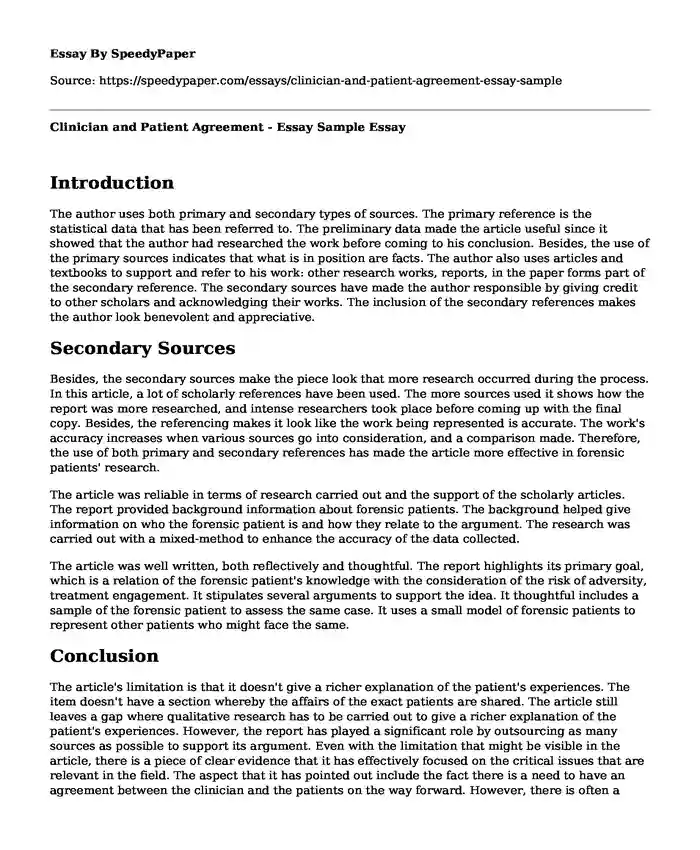
| Type of paper: | Essay |
| Categories: | Data analysis Medicine Healthcare policy |
| Pages: | 3 |
| Wordcount: | 690 words |
Introduction
The author uses both primary and secondary types of sources. The primary reference is the statistical data that has been referred to. The preliminary data made the article useful since it showed that the author had researched the work before coming to his conclusion. Besides, the use of the primary sources indicates that what is in position are facts. The author also uses articles and textbooks to support and refer to his work: other research works, reports, in the paper forms part of the secondary reference. The secondary sources have made the author responsible by giving credit to other scholars and acknowledging their works. The inclusion of the secondary references makes the author look benevolent and appreciative.
Secondary Sources
Besides, the secondary sources make the piece look that more research occurred during the process. In this article, a lot of scholarly references have been used. The more sources used it shows how the report was more researched, and intense researchers took place before coming up with the final copy. Besides, the referencing makes it look like the work being represented is accurate. The work's accuracy increases when various sources go into consideration, and a comparison made. Therefore, the use of both primary and secondary references has made the article more effective in forensic patients' research.
The article was reliable in terms of research carried out and the support of the scholarly articles. The report provided background information about forensic patients. The background helped give information on who the forensic patient is and how they relate to the argument. The research was carried out with a mixed-method to enhance the accuracy of the data collected.
The article was well written, both reflectively and thoughtful. The report highlights its primary goal, which is a relation of the forensic patient's knowledge with the consideration of the risk of adversity, treatment engagement. It stipulates several arguments to support the idea. It thoughtful includes a sample of the forensic patient to assess the same case. It uses a small model of forensic patients to represent other patients who might face the same.
Conclusion
The article's limitation is that it doesn't give a richer explanation of the patient's experiences. The item doesn't have a section whereby the affairs of the exact patients are shared. The article still leaves a gap where qualitative research has to be carried out to give a richer explanation of the patient's experiences. However, the report has played a significant role by outsourcing as many sources as possible to support its argument. Even with the limitation that might be visible in the article, there is a piece of clear evidence that it has effectively focused on the critical issues that are relevant in the field. The aspect that it has pointed out include the fact there is a need to have an agreement between the clinician and the patients on the way forward. However, there is often a disjunction where seemingly the clinician does not provide the requisite information on the mental health issue. However, this is the case when because mental health is different from any other types of ailment. The clinician might not be able to communicate with the patient since effectively.
References
Davoren, M., Abidin, Z., Naughton, L., Gibbons, O., Nulty, A., Wright, B., & Kennedy, H. G. (2013). Prospective study of factors influencing conditional discharge from a forensic hospital: the DUNDRUM-3 programme completion and DUNDRUM-4 recovery structured professional judgement instruments and risk. BMC psychiatry, 13(1), 185.
Gardner, W., Hoge, S. K., Bennett, N., Roth, L. H., Lidz, C. W., Monahan, J., & Mulvey, E. P. (1993). Two scales for measuring patients' perceptions for coercion during mental hospital admission. Behavioral sciences & the law, 11(3), 307-321.
Penney, S. R., Seto, M. C., Crocker, A. G., Nicholls, T. L., Grimbos, T., Darby, P. L., & Simpson, A. I. (2019). Changing characteristics of forensic psychiatric patients in Ontario: a population-based study from 1987 to 2012. Social psychiatry and psychiatric epidemiology, 54(5), 627-638.
Simpson, A. I., Boldt, I., Penney, S., Jones, R., Kidd, S., Nakhost, A., & Wilkie, T. (2020). Perceptions of procedural justice and coercion among forensic psychiatric patients: a study protocol for a prospective, mixed-methods investigation. BMC psychiatry, 20, 1-10.
Cite this page
Clinician and Patient Agreement - Essay Sample. (2024, Jan 11). Retrieved from https://speedypaper.com/essays/clinician-and-patient-agreement-essay-sample
Request Removal
If you are the original author of this essay and no longer wish to have it published on the SpeedyPaper website, please click below to request its removal:
- Statistics Essay Example
- Free Essay Sample on New Diseases
- Research Proposal Paper Sample: Determining the Role of the DPP9 Enzyme
- Article Review Essay Sample: More Americans Are Dying of Cirrhosis and Liver Cancer
- Essay Example on Conceptualizations of Hegemony and Habitus
- Essay on End-of-Life Preparedness: Nursing Advance Directives & Public Awareness
- Free Essay Sample on Vitamins, Herbs, and Nutritional Supplements
Popular categories




